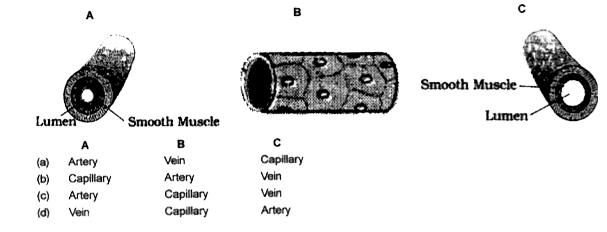which of the following blood vessels have valves to prevent the backflow of blood?
arteries
veins
capillaries
arterioies
The correct Answer is:B
To determine which blood vessels have valves to prevent the backflow of blood, we can analyze the different types of blood vessels: arteries, veins, capillaries, and arterioles.
1. Understanding Blood Vessels:
- Blood vessels are categorized into three main types: arteries, veins, and capillaries. Arterioles are smaller branches of arteries.
2. Function of Arteries:
- Arteries carry oxygenated blood away from the heart (except for the pulmonary arteries, which carry deoxygenated blood). Due to the high pressure generated by the heart's pumping action, blood in arteries flows in one direction, and thus, valves are not necessary in arteries to prevent backflow.
3. Function of Veins:
- Veins carry deoxygenated blood back to the heart (except for the pulmonary veins, which carry oxygenated blood). Blood in veins flows against gravity, especially in the limbs. To prevent backflow of blood due to gravity, veins have valves that act like doors, ensuring that blood only flows toward the heart.
4. Function of Capillaries:
- Capillaries are tiny blood vessels where the exchange of gases, nutrients, and waste occurs. They are very thin and do not require valves since blood flow is slow and controlled, and there's no significant risk of backflow.
5. Function of Arterioles:
- Arterioles are small branches of arteries that lead to capillaries. Like arteries, they also do not have valves because they are part of the high-pressure system that directs blood flow away from the heart.
6. Conclusion:
- Based on the analysis, the only blood vessels that have valves to prevent backflow of blood are veins.
Final Answer:
- Veins are the blood vessels that have valves to prevent the backflow of blood.
- Blood vessels are categorized into three main types: arteries, veins, and capillaries. Arterioles are smaller branches of arteries.
- Arteries carry oxygenated blood away from the heart (except for the pulmonary arteries, which carry deoxygenated blood). Due to the high pressure generated by the heart's pumping action, blood in arteries flows in one direction, and thus, valves are not necessary in arteries to prevent backflow.
- Veins carry deoxygenated blood back to the heart (except for the pulmonary veins, which carry oxygenated blood). Blood in veins flows against gravity, especially in the limbs. To prevent backflow of blood due to gravity, veins have valves that act like doors, ensuring that blood only flows toward the heart.
- Capillaries are tiny blood vessels where the exchange of gases, nutrients, and waste occurs. They are very thin and do not require valves since blood flow is slow and controlled, and there's no significant risk of backflow.
- Arterioles are small branches of arteries that lead to capillaries. Like arteries, they also do not have valves because they are part of the high-pressure system that directs blood flow away from the heart.
- Based on the analysis, the only blood vessels that have valves to prevent backflow of blood are veins.
- Veins are the blood vessels that have valves to prevent the backflow of blood.
Topper's Solved these Questions
Similar Questions
Knowledge Check
One of the following blood vessel is without valves
AarteryBpulmonary arteryCveinDaortaWhich of the following blood vessels possess semilunar valves
AVena cava and aortaBAorta and pulmonary arteryCPulmonary artery and pulmonary veinDPulmonary vein and vena cavaWhich of the following blood vessels bypass are present in the circulatory system before birth ?
AForamen ovaleBFossa ovalisCDuctus arteriosusDBoth (1) & (3)
See the following blood vessels and indentify it


View SolutionThe valve which prevent in the back flow of blood from right atrium is
View SolutionWhich of the following helps to dilate blood vessels ?
View SolutionWhich of the following helps to dilate blood vessels ?
View SolutionWhich blood vessels have walls only one cell thick?
View Solution

